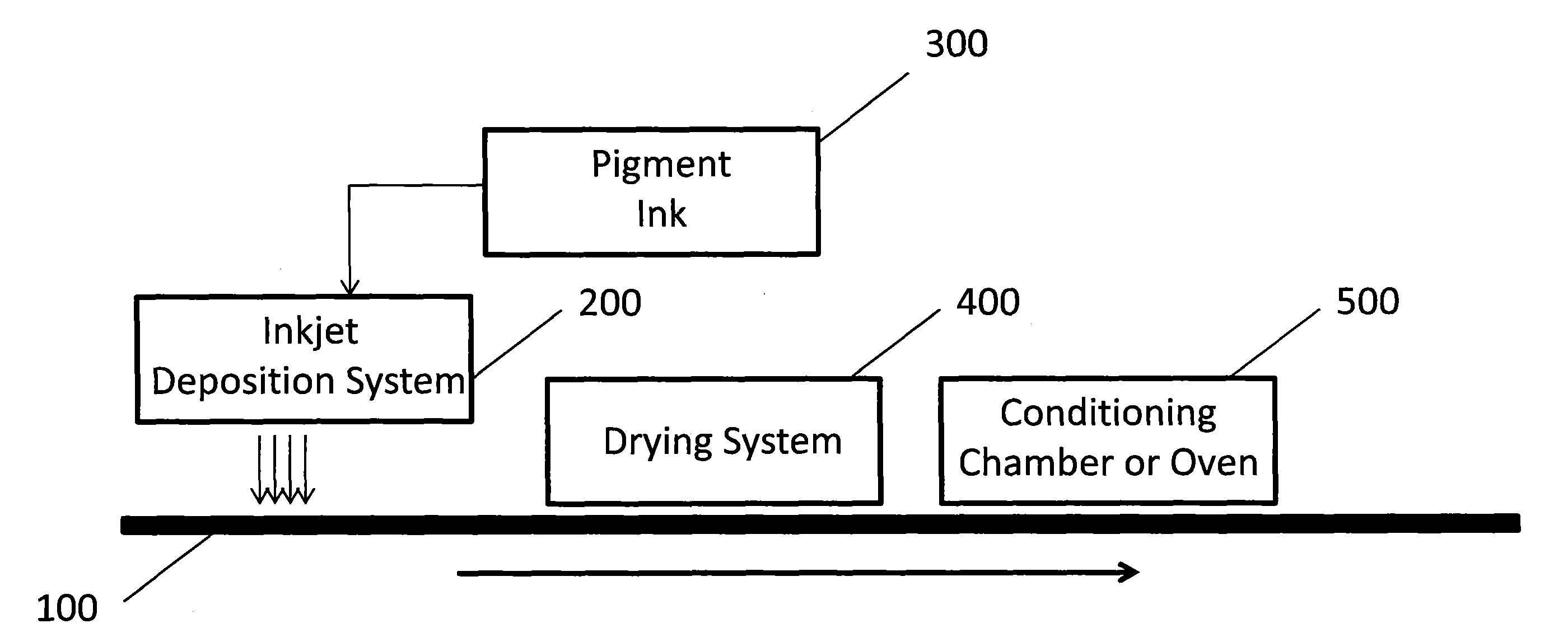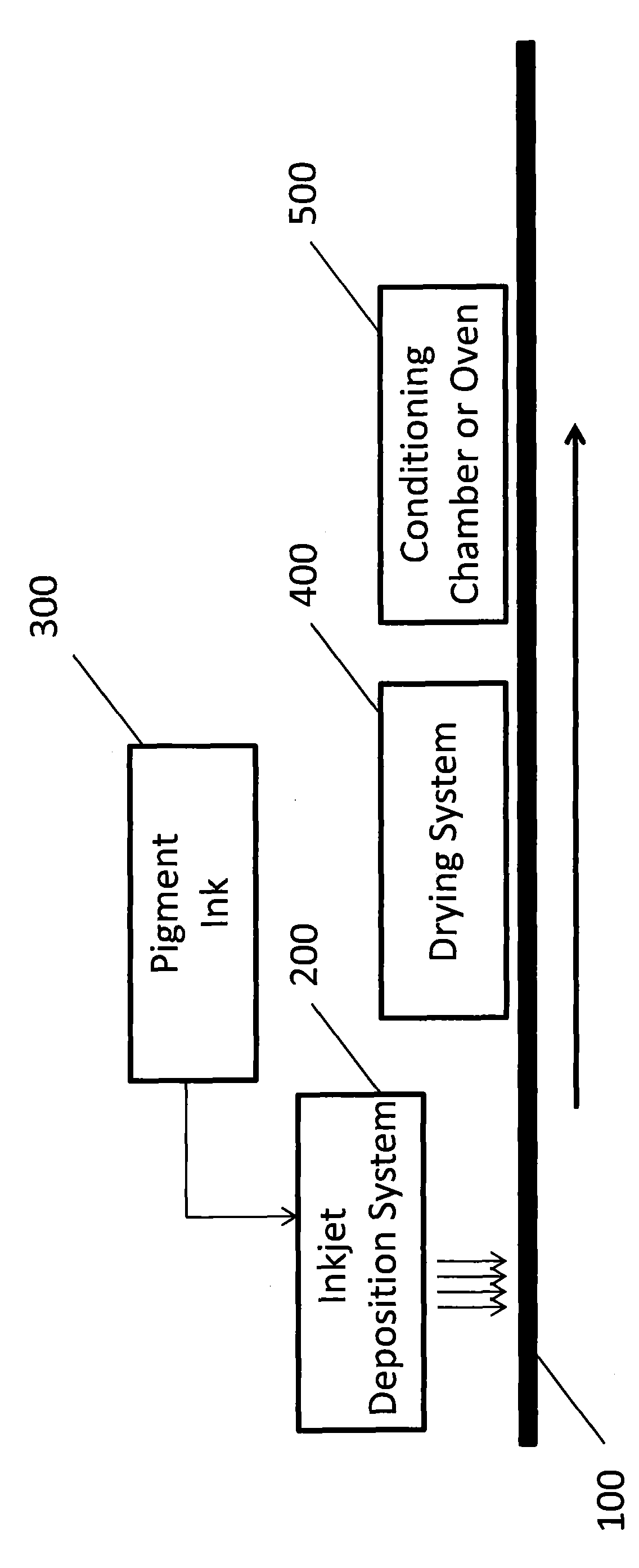Aqueous ink durability deposited on substrate
a technology of aqueous ink and durability, applied in the field of application of aqueous ink, can solve the problems of lowering optical density, printing inks can still be susceptible to smudging or offsetting, blurry or grainy images, etc., and achieve the effect of improving the durability of dried ink
- Summary
- Abstract
- Description
- Claims
- Application Information
AI Technical Summary
Benefits of technology
Problems solved by technology
Method used
Image
Examples
example 1
Oven Incubation Studies Comparing Substrates with and without Divalent Metal Salts
[0058]Utopia Book Matte (UBM), a matte coated paper intended for offset printing of trade and text books, and Utopia Book IJ (UB IJ), a matte coated paper (containing divalent metal ions in the coating) for inkjet printing of trade and text books, both manufactured by Appleton Coated Paper Company, were used for this experiment. A portion of the untreated UBM paper was surface treated as described in Example 6 in U.S. Pat. No. 8,562,126 B1. This surface-treated sample is designated t1-UBM in the following table. Note that in this prior art example, the use of the cross-linked hydrophilic coatings comprising multivalent metal cations imparted significant improvements in print quality, but wet abrasion was still considered unsatisfactory for applications such as text books.
[0059]Prints were made on a single color test fixture using a Kodak PROSPER continuous inkjet printhead and an aqueous, anionically s...
example 2
Oven Incubation Studies Comparing the Effect of Humidity
[0062]A solution comprising 4.5% Gohsefimer Z-320 polyvinyl alcohol (Nippon Gohsei), 9.9% anhydrous calcium chloride (Univar), and 5% Polycup172 solution (Ashland) was applied to Sterling Ultra Gloss text paper (NewPage, 80 lb. basis weight) to produce an inkjet receptive coating of about 0.5 g / m2 dry coating weight on the paper surface. The treated paper was then printed on a single color test fixture using a Kodak PROSPER continuous inkjet printhead and an aqueous, anionically stabilized black pigment ink of the type described in US 2007 / 0043144 A1. The resulting prints were permitted to stand before further testing at the following conditions:
[0063]A) at ambient room conditions (23° C. / 21% relative humidity) for 2 hours;
[0064]B) at ambient room conditions (23° C. / 21% relative humidity) for 24 hours;
[0065]C) in a mild oven at 40° C. / 10% relative humidity for 20 hours before removal and equilibrating at ambient room conditions...
example 3
Application of Liquid Water Followed by Immediate Re-Drying
[0072]Two types of papers were used for this experiment: Sterling Ultra Gloss (SUG), a glossy coated paper intended for offset printing manufactured by NewPage Paper Company, and Utopia Book Matte (UBM), a matte coated paper intended for offset printing, manufactured by Appleton Coated Paper Company. In this experiment, a comparison was made between commercial coated papers with and without a surface coating comprising a cross-linked hydrophilic polymer and divalent metal salt of the type described in Example 5 in US 2011 / 0279554 (t1-SUG) and Example 6 in U.S. Pat. No. 8,562,126 B1 (t1-UMB). Note again that in these prior art examples, the use of the cross-linked hydrophilic coatings comprising multivalent metal cations imparted significant improvements in print quality, but wet abrasion was still considered unsatisfactory for applications such as text books.
[0073]Prints were made on a single color test fixture using a Kodak...
PUM
| Property | Measurement | Unit |
|---|---|---|
| diameter | aaaaa | aaaaa |
| temperatures | aaaaa | aaaaa |
| basis weight | aaaaa | aaaaa |
Abstract
Description
Claims
Application Information
 Login to View More
Login to View More - R&D
- Intellectual Property
- Life Sciences
- Materials
- Tech Scout
- Unparalleled Data Quality
- Higher Quality Content
- 60% Fewer Hallucinations
Browse by: Latest US Patents, China's latest patents, Technical Efficacy Thesaurus, Application Domain, Technology Topic, Popular Technical Reports.
© 2025 PatSnap. All rights reserved.Legal|Privacy policy|Modern Slavery Act Transparency Statement|Sitemap|About US| Contact US: help@patsnap.com


